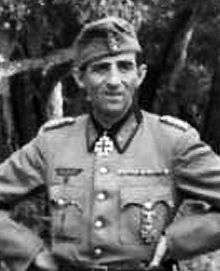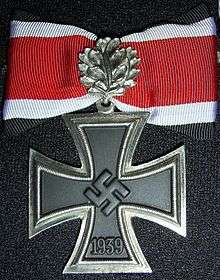Fridolin von Senger und Etterlin
| Fridolin von Senger und Etterlin | |
|---|---|
 | |
| Born |
4 September 1891 Waldshut, Grand Duchy of Baden, German Empire |
| Died |
9 January 1963 (aged 71) Freiburg, Baden-Württemberg, West Germany |
| Allegiance |
|
| Service/branch | Heer |
| Rank | General der Panzertruppe |
| Commands held |
17th Panzer Division XIV Panzer Corps |
| Battles/wars |
World War II |
| Awards | Knight's Cross of the Iron Cross with Oak Leaves |
| Relations | Ferdinand Maria von Senger und Etterlin |
Fridolin von Senger und Etterlin (September 4, 1891 – January 9, 1963) was a German general during World War II.
Career
Born into an aristocratic family, Fridolin von Senger und Etterlin began his military career in 1910 and fought in World War I. After the war he continued to serve in the Reichswehr (and later the Wehrmacht) and was promoted to the rank of colonel in 1939, while commanding the 22nd Cavalry Regiment.
World War II
Senger und Etterlin took part in the Battle of France in 1940. In October 1942, he was given command of the 17th Panzer Division in Southern Russia. In June 1943, during the Battle of Sicily he was German Liaison Officer to the Italian 6th Army (General Alfredo Guzzoni), and commanded the German units on the island until 17 July 1943 when General Hans-Valentin Hube assumed control of all Axis troops on the island. In August 1943, Senger took command of the German forces on the islands of Sardinia and Corsica. He conducted the evacuation when the German positions became untenable. On October 8, 1943, he received the command of the XIV Panzer Corps in Italy.
During the Battle of Monte Cassino, Senger und Etterlin fought at the Gustav Line, which included Monte Cassino. The German position was only broken by the Allies in May, 1944.[1]
Post war
After the war he wrote his memoirs, entitled Neither Fear nor Hope (which were translated into English), and he continued to write on military matters and theory. He was invited to the Konigswinter conferences by Lilo Milchsack. These annual conferences helped to heal the bad memories after the end of the Second World War. At the conference he worked with the politician Hans von Herwath, future German President Richard von Weizsäcker and other leading German decision makers as well as British politicians like Dennis Healey, Richard Crossman and the journalist Robin Day.[2]
In 1950, Senger und Etterlin was one of the authors of the Himmerod memorandum which addressed the issue of rearmament (Wiederbewaffnung) of the Federal Republic of Germany after World War II. He took part in a BBC Radio discussion on the Battle of Monte Cassino. He was interviewed on the BBC TV programme Face to Face in 1960.
Senger und Etterlin was introduced by B. H. Liddell Hart to the distinguished military historian Michael Howard. Howard, who had fought in Italy during the war, recalls him saying, "May I give you a word of advice? Next time you invade Italy, do not start at the bottom."[3] Senger und Etterlin died in Freiburg. He was the father of Bundeswehr General and military author Ferdinand Maria von Senger und Etterlin (1923–1987).
Awards
- Iron Cross (1939) 2nd Class (20 May 1940) & 1st Class (8 July 1940)
- German Cross in Gold on 11 October 1943 as Generalleutnant and commander of the German Wehrmacht on Corsica[4]
- Knight's Cross of the Iron Cross with Oak Leaves
- Knight's Cross on 8 February 1943 as Generalmajor and commander of the 17. Panzer-Division
- 439th Oak Leaves on 5 April 1944 as General der Panzertruppe and commanding general XIV. Panzerkorps
- Mentioned in the Wehrmachtbericht on 5 October 1943
See also
Notes
- ↑ Fridd von Senger und Etterlin (sic) An Cosantóir, n.d.
- ↑ Long Life: Presiding Genius, Nigel Nicholson, 15 August 1992, The Spectator, Retrieved 28 November 2015]
- ↑ Captain Professor, The Memoirs of Sir Michael Howard (Continuum, 2006), at page 155
- ↑ Patzwall & Scherzer 2001, p. 442.
References
- Majdalany, Fred (1957). Cassino: Portrait of a Battle. London: Longmans, Green.
- Patzwall, Klaus D.; Scherzer, Veit (2001). Das Deutsche Kreuz 1941 – 1945 Geschichte und Inhaber Band II [The German Cross 1941 – 1945 History and Recipients Volume 2] (in German). Norderstedt, Germany: Verlag Klaus D. Patzwall. ISBN 978-3-931533-45-8.
- Scherzer, Veit (2007). Die Ritterkreuzträger 1939–1945 Die Inhaber des Ritterkreuzes des Eisernen Kreuzes 1939 von Heer, Luftwaffe, Kriegsmarine, Waffen-SS, Volkssturm sowie mit Deutschland verbündeter Streitkräfte nach den Unterlagen des Bundesarchives [The Knight's Cross Bearers 1939–1945 The Holders of the Knight's Cross of the Iron Cross 1939 by Army, Air Force, Navy, Waffen-SS, Volkssturm and Allied Forces with Germany According to the Documents of the Federal Archives] (in German). Jena, Germany: Scherzers Miltaer-Verlag. ISBN 978-3-938845-17-2.
- von Senger und Etterlin, Fridolin (1963). Neither fear nor hope: the wartime career of general Frido von Senger und Etterlin, defender of Cassino. translated from the German by George Malcolm. London: Macdonald.
- Thomas, Franz (1998). Die Eichenlaubträger 1939–1945 Band 2: L–Z [The Oak Leaves Bearers 1939–1945 Volume 2: L–Z] (in German). Osnabrück, Germany: Biblio-Verlag. ISBN 978-3-7648-2300-9.
- Die Wehrmachtberichte 1939–1945 Band 2, 1. Januar 1942 bis 31. Dezember 1943 (in German). München: Deutscher Taschenbuch Verlag GmbH & Co. KG, 1985. ISBN 3-423-05944-3.
| Military offices | ||
|---|---|---|
| Preceded by Generalleutnant Rudolf-Eduard Licht |
Commander of 17th Panzer Division 10 October 1942 – 16 June 1943 |
Succeeded by Generalleutnant Walter Schilling |
| Preceded by General der Panzertruppe Joachim Lemelsen |
Commander of 14. Armee 15 October 1944 – 24 October 1944 |
Succeeded by General der Artillerie Heinz Ziegler |
